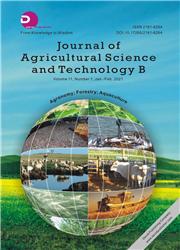Induced Polyploidy via Colchicine Treatment Increases Flower Size and Fruit Weight in Cape Gooseberry (Physalis peruviana L.)
引用次数: 1
Abstract
An induced polyploid plant through colchicine treatment offers probably the best scope for improvement in flower size and fruit weight. Thus, in the present study, an attempt was made to induce polyploidy in Cape gooseberry using colchicine with the objective of creating more genetic variability. The colchicine concentrations were used as 0.10% (C1), 0.20% (C2) and 0.40% (C3) for the duration 12 (H1), 24 (H2) and 36 (H3) hours for each concentration with seedling apex dip method (M1), cotton plug method (M2) and lanolin paste method (M3). The plants treated with 0.10% of colchicine by cotton plug method for 12 h showed the better performance during the years 2017-2018 and 2018-2019 in respect of more delay in the flower bud emergence (54 d and 53 d from the date of transplanting), anthesis (19 d and 20 d from the first appearance of bud to full anthesis of flower) and fruit setting (8.00 d and 9.00 d from the date of anthesis), bigger flower size (2.93 cm and 3.00 cm) than the untreated plants. The lower percentage of pollen viability (40.33% and 40.67%) was noticed in the same treatment in comparison to control (70.33% and 72.33%). The fruit maturity was also extended (59 d and 60 d from the date of fruit set) with bigger sized fruits (length: 2.53 cm and 2.57 cm, breadth: 2.27 cm and 2.33 cm) as well as more fruit weight (8.70 g and 8.33 g) by the application of colchicine at 0.10% with cotton plug method for 12 h. On the basis of results obtained, the application of colchicine at 0.10% for 12 h duration with cotton plug method was found to be the best and effective treatment for induction of polyploidy as well as more flower size and fruit weight in Cape gooseberry.秋水仙碱诱导醋栗多倍体增加花的大小和果实的重量
通过秋水仙碱处理诱导的多倍体植物可能提供了改善花朵大小和果实重量的最佳范围。因此,在本研究中,试图用秋水仙碱诱导开普醋栗多倍体,目的是创造更多的遗传变异性。秋水仙碱浓度分别为0.10%(C1)、0.20%(C2)和0.40%(C3),持续时间分别为12(H1)、24(H2)和36(H3)小时。用0.10%秋水仙碱棉塞法处理12 h的植株在2017-2018年和2018-2019年表现出更好的花蕾出苗延迟(自移植之日起54 d和53 d)、开花延迟(自芽初出现至花完全开花19 d和20 d)和坐果延迟(自开花之日起8.00 d和9.00 d),花的大小(2.93cm和3.00cm)比未处理的植物大。与对照组(70.33%和72.33%)相比,同一处理的花粉活力百分比较低(40.33%和40.67%)。果实成熟度也有所延长(自结实之日起59天和60天),果实较大(长2.53厘米和2.57厘米,宽2.27厘米和2.33厘米),果重增加(8.70克和8.33克)结果表明,用棉塞法施用0.10%秋水仙碱12h是诱导开普醋栗多倍体、增大花径和果实重量的最佳有效处理。
本文章由计算机程序翻译,如有差异,请以英文原文为准。
求助全文
约1分钟内获得全文
求助全文

 求助内容:
求助内容: 应助结果提醒方式:
应助结果提醒方式:


